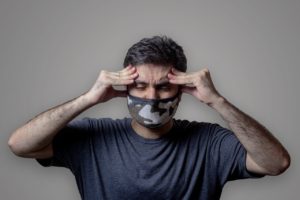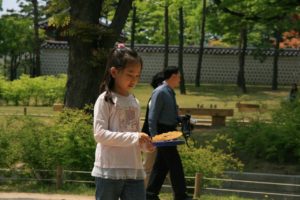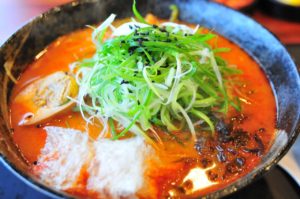Master the Most Important Korean Particles
In this post we’ll give an overview of Korean particles. Particles are small functional words that play some sort of functional role in a sentence, for instance marking topics, subjects, direct objects, location, and so son. Some of these particles may be dropped in casual speech, but if you’re learning Korean, it’s important to understand how they’re used. As a general rule of thumb, you shouldn’t drop particles until you have a good sense of whether or not Koreans drop them. And as in all things Korean, you should also be aware of the level of formality when you’re speaking. The more formal or respectful the situation, the less you should drop those particles!
Topic and Subject Particles –은 -eun / –는 -neun and –이 -i / –가 -ga
The first two particles that students of Korean encounter tend to be the topic particle –은 -eun / –는 -neun and the subject particle –이 -i / –가 -ga. The topic particle marks the topic; the person, thing, place, time, etc., that the sentence is about. This is not the same as a grammatical subject, although English translations often make it difficult to see this.
- 저는 학생이에요.
jeo-neun haksaeng-ieyo.
I’m a student. [As for me: I’m a student] - 이 책은 재미있어요.
i chaek-eun jaemiisseoyo.
This book is interesting. [This book: it’s interesting]
The subject particle marks the subject of the sentence. Many typical Korean sentences include a topic, marked by –은 -eun / –는 -neun, and then a different subject, marked by –이 -i / –가 -ga, further in the sentence.
- 지호는 새 차가 있어요.
jiho-neun sae cha-ga isseoyo.
Jiho has a new car. [For Jiho: there is a car] - 한국은 산이 아름다워요.
hangug-eun san-i areumdaweoyo.
The mountains in Korea are beautiful. [korea: mountains are beautiful]
If your language doesn’t have this topic/subject distinction – for example, English – this can be quite confusing. We’ve written a detailed post covering the difference between topics and subjects, so please check it out.
Direct Object Particle: –을–eul / –를 –reul
Direct objects are marked with the object particle. –을 is attached to nouns or pronouns that end in consonants, and –를to nouns or pronouns that end in vowels.
- 저는 밥을 먹어요.
jeo-neun bap-eul meogoyo.
I eat steamed rice. - 문을 연다.
mun-eul yeonda.
She opens/He opens the door. - 우리는 차를 샀어요.
uri-neun cha-reul sasseoyo.
We bought a car. - 개가 나를 봐요.
gae-ga na-reul bwayo.
The dog sees me. - 몇개 언어를 하세요?
myeotgae eoneo-reul haseyo?
How many languages do you speak?
Possessive Particle: –의 –e
The possessive particle –의 –e marks the possessor, corresponding to the English preposition of or the ‘s possessive construction. It is usually pronounced -e rather than –ui in spoken Korean.
- 이것은 빌의 컴퓨터예요.
igeos-eun bil-e keompyuteo yeyo.
This is Bill’s computer. - 학생의 컴퓨터는 새 것입니다.
haksaeng-e keompyuteo-neun sae geosh imnida.
The student’s computer is new. - 개의 이름이 뭐예요?
gae-e ireum-i mwoyeyo?
What’s your dog’s name?
Location/Movement Particle: –에 / –e
The particle –에 –e is used to mark movement, corresponding to the English preposition to.
- 저는 지하철역에 가요.
jeo-neun jihacheolyeog-e gayo.
I’m going to the subway station. - 우리는 식당에 가요.
uri-neun shikdang-e gayo.
We’re going to a restaurant. - 이번 주말 파티에 누가 와요?
ibeon jumal pati-e nuga wayo?
Who’s coming to the party this weekend?
The same particle marks (static) location with the verb 있다 itda (to exist, to be located) and its negative 없다 eobda.
- 어디에 있어요?
eodi-e isseoyo?
Where are you?/is it? - 아이가 도서관에 있어요.
ai-ga doseogwan-e isseoyo.
The child is at the library. - 빌은 집에 없어요.
bil-eun jib-e eobseoyo.
Bill isn’t home. - 포크, 칼, 수저는 서랍에 있어요.
pokeu, kal, sujeoneun seolab-e isseoyo.
The forks, knives, and spoons are in the drawer.
This particle is used in many other location expressions.
- 화장실은 침실 옆에 있어요.
hwajangshil-eun chimshil yeop-e isseoyo.
The bathroom is next to the bedroom. - 차는 집 앞에 있어요.
cha-neun jip ap-e isseoyo.
The car is in front of the house. - 정원은 집 뒤에 있어요.
jeongweon-eun jib dwi-e isseoyo.
The garden is behind the house.
It’s also used in many time expressions.
- 아침에 운동해요.
achim-e undonghaeyo.
I work out in the morning. - 한시에 점심을 먹어요.
hanshi-e jeomshim-eul meogeoyo.
I eat lunch at one o’clock. - 토요일에 장봐요.
toyoil-e jangbwayo.
I go grocery shopping on Saturday. - 이월에 그 책을 읽었어요.
iweol-e geu chaeg-eul ilgeosseoyo.
I read that book in February.
Dynamic Location Particle: –에서 -eseo
Static location (where someone/something is) is marked with –에 –e, but dynamic location (where someone does something/where something happens) is marked with –에서 -eseo.
- 집에서 텔레비전을 봐요.
jib-eseo tellebijeon-eul bwayo.
I watch television at home. - 침실에서 음악을 들어요.
chimshil-eseo eumag-eun deuleoyo.
I listen to music in the bedroom. - 버스에서 신문을 읽어요.
beoseu-eseo shinmun-eul ilgeoyo.
I read the newspaper on the bus. - 아이들은 학교에서 많은 것을 배운다.
aideureun hakgyoeseo maneun geoseul baeunda.
Children learn a lot in school. - 대학교에서 무엇을 공부해요?
daehakgyo-eseo mueoseul gongbuhaeyo?
What do you study at university?
and/with: –와 -wa / –과 -gwa
The particles –와 -wa and –과 -gwa are used to link two nouns (and) and also to express with. –와 -wa is attached to a word ending in a vowel, and –과 -gwa is attached to a word ending in a consonant.
- 우리는 텔레비전과 소파가 있습니다.
uri-neun tellebijeon-gwa sopa-ga isseumnida.
We have a television and a sofa. - 나는 차와 커피를 마셔요.
na-neun cha-wa keopi-reul masheoyo.
I drink tea and coffee. - 친구와 차를 마셔요.
chingu-wa cha-reul masheoyo.
I’m drinking tea with a friend. - 친구들과 함께 나가요.
chingudeulgwa hamkke nagayo.
I go out with my friends. - 저녁을 가족들과 먹어요.
jeonyeog-eul gajogdeulgwa meogeoyo.
I eat dinner with my family.
Indirect Object Particle to: –에게 -ege
The Korean particle –에게 -ege expresses to in the sense of an indirect object, the recipient of a direct object.
- 친구에게 이메일을 보내요.
chingu-ege imeil-eul bonaeyo.
I’m sending an email to a friend. - 동료에게 이메일을 쓰고 있어요.
donglyo-ege imeil-eul sseugo isseoyo.
I’m writing an email to my colleague. - 언니에게 책을 줬어요.
eonni-ege chaeg-eul jweosseoyo.
I gave a book to my sister. - 전체에게 답장해 주세요.
jeonche-ege dabjanghae juseyo.
Please reply all / to everyone.
Instrumental Particle with/by/in: –(으)로 -(eu)lo
The particle –(으)로 -(eu)lo is used to mark the instrument with or by which something is done. It is also used with languages, translating as in. –로 -lo attaches to words ending in vowels or the consonant ㄹ– l-and –으로 –eulo attaches to all other consonants.
- 연필로 씁니다.
yeonpil-lo sseumnida.
I write with a pencil. - 그 사람들은 영어로 말했어요.
geu saramdeul-eun yeongeo-lo malhaesseoyo.
Those people spoke in English. - 한국어로… 를 뭐라고 해요?
hangugeo-lo… -reul mworago haeyo?How do you say… in Korean? - 젓가락으로 먹었어요.
jeotgarag-eulo meogeosseoyo.
I ate with chopsticks. - 태블릿으로 모든 것을 할 수 있어요.
taebeullis-eulo modeun geos-eul hal su isseoyo.You can do everything on/with a tablet. - 나무 숟가락으로 스프를 저어요.
namu sudgalag-eulo seupeu-leul jeoeoyo.
I stir soup with a wooden spoon.
Get on the road to speaking Korean with the Language Garage!
We hope you’ve enjoyed learning about Korean Particles. If you’d like to learn more:
- Follow us on Facebook, LinkedIn, BlueSky, Twitter, Threads, Instagram, or Pinterest. We publish lots of Korean vocabulary, grammar, and culture notes, so it’s a great way to pick up some new vocabulary and practice.
- Check out our other posts on Korean language, culture, and more.
- Enroll in affordable, flexible, and personalized private online Korean lessons or sign up for a small group online Korean class.
- Create a free Language Garage account to access tons of Korean vocabulary, grammar, and culture.
Photo by Pixabay






